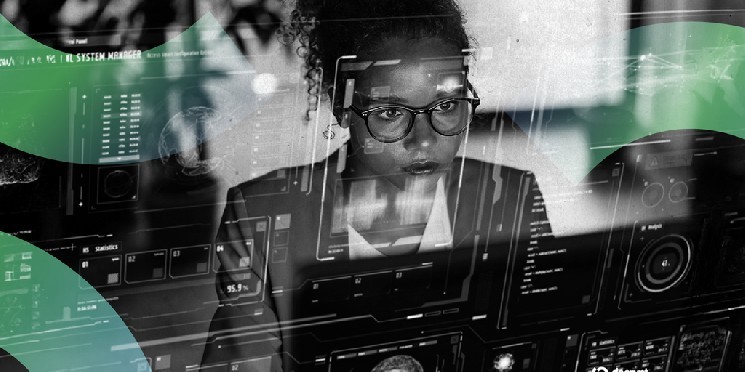AI surveillance tools once confined to battlefields are now being used by U.S. immigration authorities to monitor streets, protests, and communities across the country.
U.S. Immigration and Customs Enforcement (ICE) and other federal agencies are ramping up their use of facial recognition, predictive AI, and military-grade drones.
That’s sparked alarm among civil liberties advocates over privacy, oversight, and the targeting of undocumented immigrants and U.S. citizens alike.
Last weekend, as protesters marched through downtown Los Angeles, a drone hovered overhead tracking vandals, looters, and those attacking federal agents—an example of how AI-powered surveillance is increasingly entering public spaces.
Two days later, the Department of Homeland Security posted footage on X, reportedly captured by a Predator drone, showing scenes from the protest. The video highlighted the increasing use of military-grade technology in domestic surveillance.
“There are always concerns around drone use, partly due to perception,” CEO of drone detection company SkySafe, Grant Jordan, told Decrypt. “When an average person sees a drone, they don’t know its purpose or who’s operating it. Unlike helicopters, where the operator is clear, drones are remote and ambiguous.”
Among the most aggressive adopters of surveillance technology are the Department of Homeland Security and U.S. Immigration and Customs Enforcement, which have integrated AI into nearly every phase of immigration enforcement, from identifying individuals to predicting their likelihood of skipping court dates.
WATCH: DHS drone footage of LA rioters.
This is not calm. This is not peaceful.
California politicians must call off their rioting mob. pic.twitter.com/WHNPlzEJG8
— Homeland Security (@DHSgov) June 10, 2025
In addition to drones and AI-enabled cameras, ICE employs a variety of AI-powered systems that operate behind the scenes in enforcement and detention decisions.
Here are some of the key technologies in use:
Palantir’s Immigration Lifecycle Operating System (ILOS)
- Also known as the ImmigrationOS, Palantir’s ILOS creates detailed profiles of deportation targets using integrated federal datasets and real-time monitoring.
Mobile Device Analysis
- Used by investigators and analysts to identify and extract evidence, relationships, and networks from mobile device data, utilizing machine learning capabilities to determine locations of interest.
Voice Analytics and Translation
- A voice analytics tool that utilizes machine learning to transcribe and translate multilingual audio, enabling agents to more efficiently identify investigative leads and analyze evidence without relying solely on manual review.
Facial Recognition Technology
- Used by Homeland Security Investigations to identify victims and perpetrators in child exploitation cases. The technology generates leads on potential identities of victims and offenders; however, ICE said no enforcement action is taken based solely on these leads.
Hurricane Score
- Predicts compliance risk for non-detained immigrants in ICE’s supervision program. Hurricane Score is a quasi-binomial, binary classification machine learning model that is given information about an individual and determines the probability that the individual will fail to appear for a hearing, based on patterns the model has learned from inactive case data.
While federal agencies argue the tools improve efficiency and public safety, civil liberties advocates warn they are often deployed without transparency or oversight, posing a chilling threat to privacy and disproportionately affecting immigrant and marginalized communities.
“We know immigrant communities face disproportionate policing, particularly Black and brown immigrants, and surveillance tech is part of a larger system of control to police their daily lives,” Citlaly Mora with the non-profit organization Just Futures Law, told Decrypt.
“We know that DHS has an arsenal full of weaponized technology, and its main purpose is to identify and ultimately deport individuals. In the hands of ICE, these technologies present a danger to our communities’ safety,” Mora added.
She continued: “Surveillance of any kind, especially when conducted by government or law enforcement, has the potential to chill speech and people’s First Amendment rights. When it comes to groups who are exercising their right to protest or immigrant communities, we know surveillance is used to target them and cause adverse effects.”
Advocates argue that community engagement is crucial in combating the unchecked spread of surveillance technology at the local level.
“In addition to becoming politically active, it’s important not to simply accept these technologies and how the government uses them,” Jay Stanley, senior policy analyst with the ACLU, told Decrypt.
“Local law enforcement and other agencies are supposed to serve the public. That means if communities object and say, ‘We do not want the police using drones over our neighborhoods or tracking and storing our movements,’ that should be respected,” Stanley added.
Stanley also said communities shouldn’t accept the use of surveillance technology as inevitable.
“We can’t stop its development, but we can decide how it’s deployed in our communities and how government agencies are, and are not, allowed to use it,” he said.
ICE and the DHS did not respond to Decrypt’s requests for comment.
Edited by Sebastian Sinclair
Read the full article here









